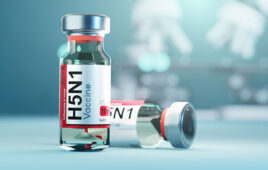Dean Haycock
Contributing Editor
Research into bacterial signal transduction could improve antimicrobial drug discovery now and in the future.
In the past, new antibiotics were discovered by screening for their ability to prevent bacterial growth. During the past decade, researchers have begun investigating other approaches to developing antibacterial agents. Some of the most promising targets were thought to be microbial signaling systems known as two-component signal transduction pathways (TCSs).
They are appealing targets: TCSs are widespread in bacteria and absent in mammals. Pathogens use TCSs to sense their environment and to control the expression of virulence factors. In some species, they regulate resistance to drugs such as vancomycin and tetracycline.
TCSs are phosporylation-dependent signal transduction systems. An external stimulus in the environment interacts with the bacterial cell membrane. This causes an enzyme, such as a histidine protein kinase (HPK), to phosphorylate itself. The phosphorylated HPK transfers phosphate to a response regulator (RR) protein. The phosphorylated RR, now activated, interacts with DNA to regulate gene transcription.
Many companies, including Johnson & Johnson, initiated screening programs to identify TCS inhibitors. Chemical library screens yielded leads in the form of triphenylalkyl derivatives, diaryltriazole analogs, salicylanilides, bisphenols, cyclohexenes and benzoxazines. Unfortunately, poor selectivity and safety drawbacks held these candidates back. Few publications now describe compounds that inhibit two-component systems.
“You look at them and say, ‘Well these are nice compounds but they’re probably the same kind of [compounds] that everybody else is looking at, some kind of aromatic hydrocarbon with a positive charge that ends up to be soap in the end,’” says James Hoch, PhD, professor of molecular and experimental medicine at the Scripps Research Institute, La Jolla, Calif.
Overcoming the past
The result, according to Steve Projan, PhD, vice president of discovery research, Wyeth Research, is that “there are very few attempts being made to find inhibitors of signaling pathways. . . . This is really not a very fertile field for antibacterial drug discovery. I will say it hasn’t been and probably will not be. We’ll learn more science than we will get antibacterials from it.”
Thomas Dick, PhD, head of the Tuberculosis Unit at Novartis Institute for Tropical Diseases in Singapore, did some exploratory work on the sensor histidine kinases (DosS, DosT). “We developed enzyme assays and screened some small libraries,” he said, “but did not find anything attractive.”
The problem, according to Dick, is that DosS is “a difficult target in terms of feasibility” because of difficulty assaying it. And knocking out DosS and DosT genes showed less severe phenotypes than knocking out DosR. “I guess that’s a general problem with targeting sensor kinases,” Dick said, “There are often several and there is some ‘redundancy’.”
Everyone agrees that two-component systems control important virulence-encoded processes as well as other basic prokaryotic functions. But, Hoch points out, “The key word here is control. They don’t necessarily absolutely control these things.” Bacteria are so adaptable; they can readily adjust to changes in their environment, even to drugs targeting their signaling systems.
Many researchers, however, can see a promising adjunct role for drugs targeting TCSs.
“By itself I don’t think a particular inhibitor of a particular virulence pathway is going to be an effective antibiotic,” says Sarah Ades, PhD, assistant professor, department of biochemistry and molecular biology, The Pennsylvania State University, University Park, Pa. “One way I view my research is that these antibiotics could be used in combination with an existing one, maybe making it more effective.”
In this case, Hoch suggests, new antibiotics targeting TCSs might turn out to be useful like Augmentin, which combines the semi-synthetic penicillin, amoxicillin, and the penicillinase inhibitor clavulanic acid. “If you give them [new drugs targeting TCSs] in combination with something whose activity is now enhanced because of the inhibition, then there might be a role for them out there,” Hoch said. But Hoch believes such a goal is not necessarily encouraged by many pharma executives. “They want bactericidals. It’s very difficult to pass this. Most of these programs have been shut down.”
Targeting proteins or genes closely associated with TCSs might offer some promise. TCS genes and ABC transporter genes do not belong to the same transcriptional unit. ABC transporters can import or export a variety of compounds across cell membranes.
“Many of these transporters are involved in the elimination of toxic substances from the bacterium’s environment,” says Projan. Because the genes of TCSs are adjacent to ABC transporters, the implication is the two component regulatory system can regulate the ABC transporters. As the authors of the report state: “The ABC transport and TCS systems are functionally linked, each response regulator controlling the expression of its cognate but not its own.”
Successfully targeting those types of transporters could “probably make the bacteria pretty sick because they can’t eliminate toxic substances from their environment,” says Projan.
One field outside of microbiology that might provide inspiration for antibacterial drug discovery is oncology. “Keep in mind,” Projan said, “in oncology we’re seeing continuing success with people targeting signaling pathways but never a stand-alone therapy. Usually it’s always polypharmacy, multiple drugs in oncology, for going after the signaling pathways plus other things.”
About the Author
Dean A. Haycock, Ph.D., is a science and medical writer based in New York.
This article was published in Drug Discovery & Development magazine: Vol. 10, No. 7, July, 2007, pp. 30-31.
Filed Under: Drug Discovery



